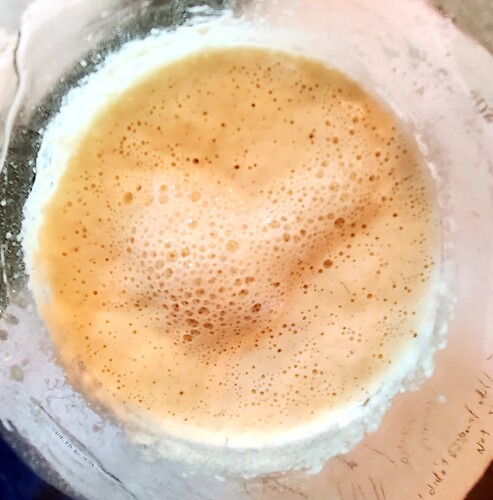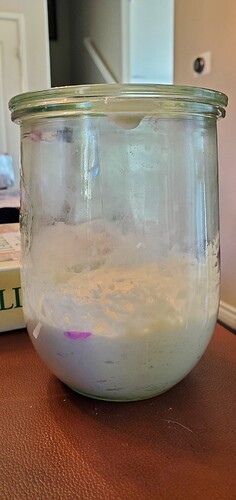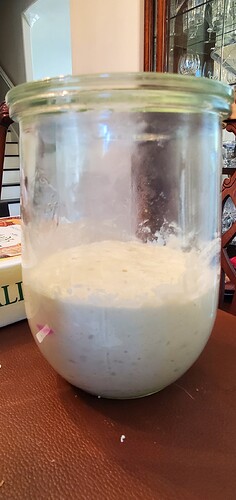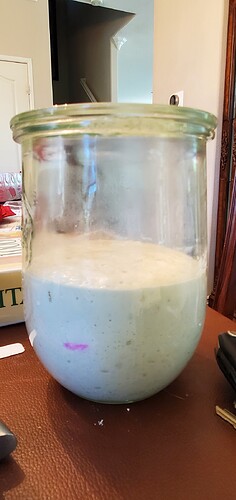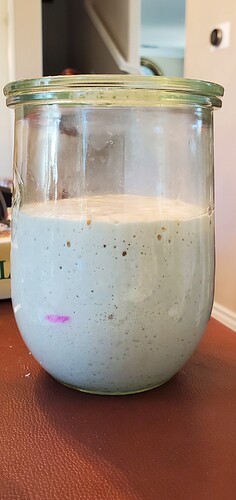The instructions for the dried starter suggest covering the container with plastic wrap after the first couple feedings. Am I correct in assuming that thereafter, most folks only loosely cover the container, such as the glass lids on a Weck jar?
I use a screw top container but don’t put the lid on tightly. Enough to keep bugs out and to allow the air to escape. I do this when making a starter from scratch. When it’s done and stored in the fridge then I’ll tighten the lid after the starter has been fed and doubled.
May I suggest for your dried starter you follow the first feed but don’t feed again for 24 hours. After which discard half and top back up. Once you see good activity switch to 12 hourly feeds. Once it’s ready you only need to keep a little at any one time and store in the fridge. When it comes to baking feed it, allow it to bubble up, take off however much you need for the recipe and return the excess to the fridge. At this stage you should be keeping a small amount and each feed should be a healthy one. This means fresh flour should be equal to, or more than, however much starter you have by weight.
Thanks. I’ll be doing that. This is my second time around with this dried starter and I might have abandoned my starter too quickly. Are the bubbles generally smallish?
Bubbles can vary depending on flour and hydration. Might I suggest you follow these instructions? Easiest starter i’ve made. Organic flour is also recommended. Using boiled tap water which has been cooled is also a good idea.
How much dried starter do you have?
Personally, I will not use/eat any grains from N America that is not organic. The brains of the UK, the Scottish, figured out that spraying a wicked herbicide, Glyphosate (Monsanto’s Roundup), on grain 10-14 days before harvest would substantially increase the harvest yield. The practice has been adopted in N America, and ironically, at the same time, the US federal government raised the allowable limit of Glyphosate detected in grain for human consumption by 30-TIMES! Glyphosate is not allowed to be used on grains sold as ‘organic’. That said, there is still glyphosate detected on organic grains but at a much lower level.
Maybe it is still ok on your side of the pond. That does not work anymore, here. In the US, federal mandates require the municipalities “treat” or condition the water with chemistry specifically to kill-off bacteria, algae, and fungus in the water distribution network (pipes). One of the chemicals used is chloramine, replacing the chlorine that used to be used. You are correct that chlorine will rapidly dissipate with boiling, or overnight if water is left sitting on the counter. Chloramine, however, is not so affected by boiling and takes about a month or more to dissipate on its own. Bottled water or RO filtered (reverse osmosis) water is recommended in the States.
Chloramine is ammonia that has its nitrogen atoms replaced with chlorine atoms.
Honestly, Abe, we suffer on this side of the pond.
America is meant to be the land of the plenty. Plentiful in what? Pesticides and Chloramine? Think I’d need a lie down after trying to figure my way through all that, Otis.
Even without boiling the tap water seems to work fine with starters here. I just do it out of habit that was born out of advice but not really needed. As for flour there’s plentiful organic, not every flour though, and bleached flour is banned here unless it’s imported. Even our white flours are more off white.
i don’t have any more dried starter.
i take it this recipe is for naturally existing yeasts then?
Yes, no dried starter needed. This is just flour and water with a little honey for the first feed only. Dried starter should also be natural yeast. Where dried starter is activating an existing starter this recipe starts from scratch.
Should you have had any left I was going to advise following the recipe using some dried starter to kick start the process. In other words using the recipe schedule to revive your dried starter. If you started already you can still follow it.
What have you done so far?
My starter is doing what it did the first time and was the reason I dumped the first batch. I think I’m too used to virulent starters that rise aggressively. As you can see, there are plenty of bubbles (small), but volume probably only increased by about 15% after feeding. Pic attached.
Looks good to me. I’ve used starters which looked like that and they’ve risen bread just fine. Can you give a brief history of this starter and what kind of feed you’ve given it.
this is only day 4. i merely have followed the directions from the website host re reviving dry starter. which is as follows (all AP flour) …
Day 1: In a pinch bowl, soak 1 ½ teaspoons dried starter in 1 tablespoon lukewarm purified or spring water for a few minutes to soften. Then stir in 1 tablespoon all-purpose or bread flour, cover with plastic wrap and let sit at room temperature for 24 hours.
Day 2: To the above mix, stir in 1 tablespoon of flour and 2 teaspoons of water and let it continue to sit covered as before for another 24 hours.
Day 3: Stir in 1 more tablespoon of flour and just 1 teaspoon of water this time. Within the next 12 to 24 hours you will likely start to see some bubbling action of fermentation. The warmer the room, the faster the activation.
Now transfer your activated starter to a jar with plenty of extra space for expansion, and stir in 1/3 cup flour and 1/4 cup of water. Mark the level on the jar with a rubber band. Within about 12 hours you should have a lively, spongy starter.
That’s quite sound and you have a healthy looking starter. So far you’ve only added flour and water but each time you fed it, except for the 4th time, the feed ratio to starter was less. So there’s more fermented starter to fresh feed. Which is fine at the beginning but once it begins to get lively the feeds should match it and get increasingly healthier which means a higher ratio of fresh flour to starter.
For your next feed (day 5) try 1/4 cup starter + 1/2 cup water (mix till fully distributed) + 1 cup flour. That is now an even healthier feed of around 60g starter + 118g water + 120g flour which is near enough 1:2:2. That’s less over fermented starter to more fresh flour.
I’ve also noticed the ratio of flour to water in the instructions is around 40g flour to 59g water which makes it 148% hydration which is very high. Of course it’s only going to froth instead of rise. That’s to be expected.
If on day 5 you follow my recommended feed not only is it a healthy feed it’ll lower the hydration and rise more. See how it reacts and let me know.
thx, i’m going to do just that and return with results
It became rather clear to me that my starter was way too loose. I know some folks want that for specific purposes, but I first wanted to assure that this strain had good vitality by seeing at least a double in volume. That being said, your proportions seem to be right on and I followed them exactly.
Starter was fed at 8:15 AM
9:25 AM
11:42 AM
12:34 PM
2:33 PM
That looks perfect to me. Time for a bake I think. Looking forward to your first bread with this very healthy looking starter. I kinda figured it was going to take off like that once you thickened it up.
yes, thx again
